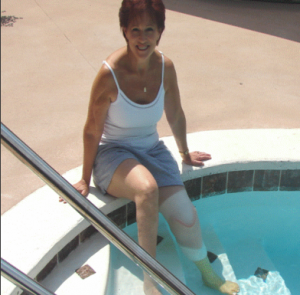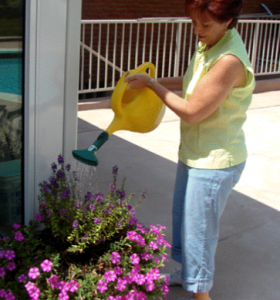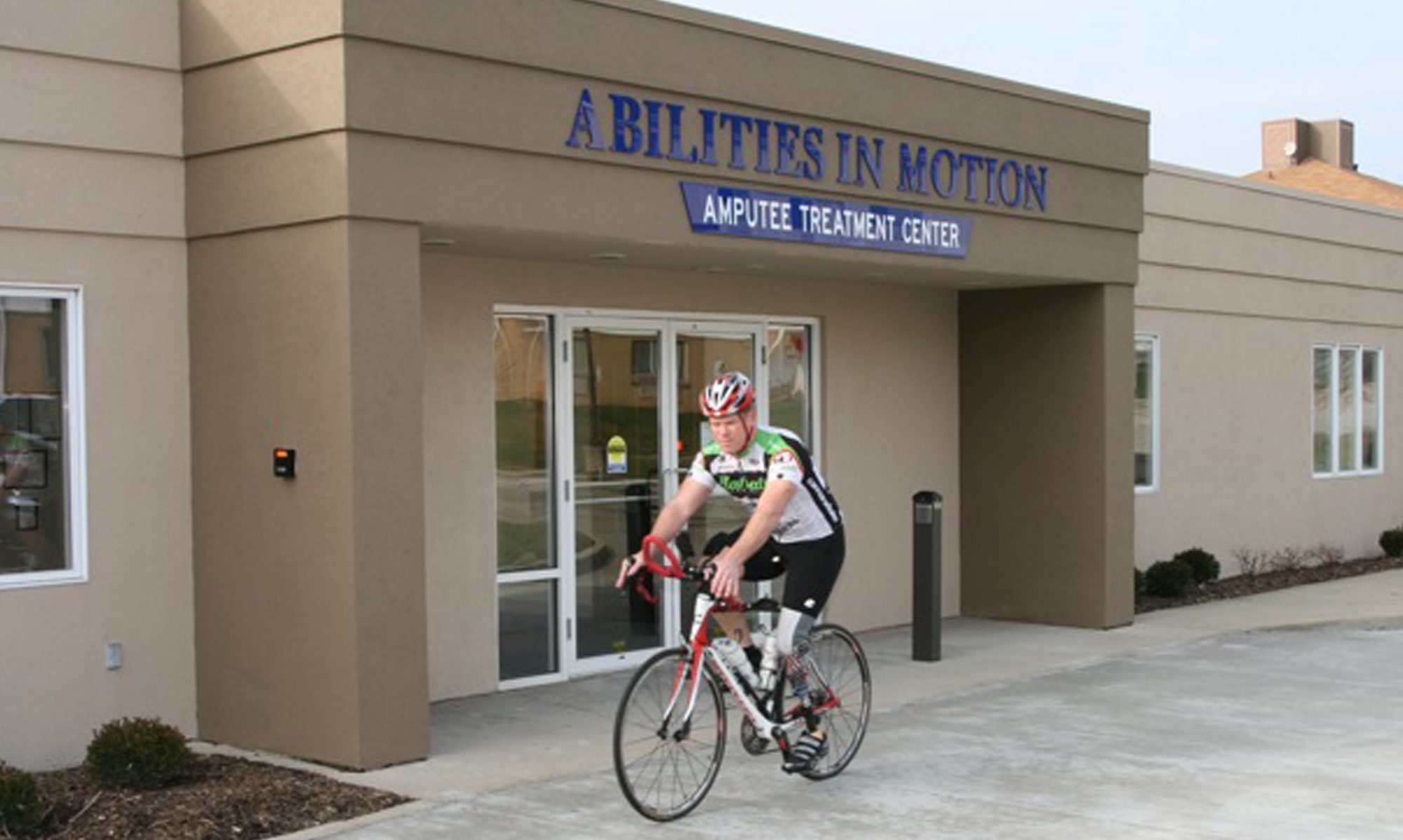Mark and his custom UK Socket
Abilities In Motion, Testimonial by Don
Gerald Evans

Gerald Evans is a basketball man. Simply put, he loves the sport. A keen player for many years, Gerald has been talking about it since we first met him.
Gerald has been playing basketball all his life, starting with playing on youth teams. He also played for Woodward High School and started as a center.
In his college years, Gerald continued to play ball. He started for two years as a forward for Cincinnati State University.
He went on to play many years of pick up games after he finished college. Gerald would often play several times a week.
When we began his rehabilitation from his amputation, basketball was always part of the conversation.
At first he would joke about getting his jump shot back. This was when he was getting measured for his first prosthesis.
After fitting him with his initial prosthesis which included a highly efficient energy storing foot, Gerald quickly transitioned to a cane, then walking without assistance in just a couple of months.
Gerald keeps himself in shape at home using a treadmill, which he uses daily.
More recently, he was fit with an elevated vacuum system, which provides greater control of the prosthesis. This system has really helped Gerald on the court. He has been working hard with the new prosthesis on perfecting his jump shot. He told us that the new system has really helped with the control needed to jog around the court and to jump in the air without having to worry about the landing.
So with the jump shot now perfected, there is just the matter of working on the slam dunk!
When we asked Gerald if this was a goal of his, he replied,
“It’s been many years since I last did that! Maybe it’s something to look forward to, but not today.”
Keep up the great work Gerald. Once you get that slam dunk down, you’ll be ready to play a little one on one against Tom!
Benefit Questions
Although most people know about Social Security retirement benefits, far fewer know that people with disabilities—those who can no longer work because of injury or illness—may also qualify for Social Security benefits, regardless of their age. The process of obtaining such benefits can be confusing and as a result there are many misunderstandings. Here are a couple of myths explained from the inMotion Magazine May Edition.
1. If I am disabled, it is easy to obtain disability benefits.
Actually it can be a difficult and frustrating procedure. Initially you must be interviewed either in person or via phone. The majority of applicants are turned down upon initial application. However chances of approval increase when you file an appeal, which can take differing forms in each state.
2. Disability benefits and Medicare benefits are unrelated.
Once you have received disability benefits for 24 months, you qualify for Medicare benefits, regardless of age. The rules for disability are complicated, and you should seek assistance to determine whether you are eligible for benefits and to assist you in applying for them.
Jan Beckemeyer
 Jan Beckemeyer first came to AIM in August of 2005, for a consultation considering a below knee amputation. She had been through multiple surgeries after a motorcycle accident, which resulted in an artificial ankle. She had continued pain which was not improving, and it had become increasingly difficult to function.
Jan Beckemeyer first came to AIM in August of 2005, for a consultation considering a below knee amputation. She had been through multiple surgeries after a motorcycle accident, which resulted in an artificial ankle. She had continued pain which was not improving, and it had become increasingly difficult to function.
Jan is very active and was considering an ankle fusion or an amputation. After speaking with her surgeon, Tom Walsh, and several of AIM’s patient advocates, she decided to undergo a below knee amputation on September 21st 2005. She remarked, “at some point you get to the stage where you have to decide if you want to continue a life of pain, or take a chance on another way. I knew there was a chance that I may not get all that I was looking for, but I was willing to take the chance, and for me it has worked out really well”. Together with her husband, Ron, a retired engineer, they discussed the pros and cons and educated themselves on what was ahead.
Jan was initially fitted with an Immediate Post Operative Prosthesis, which allowed for early ambulation. She experienced some phantom pain, but otherwise healed very well. By mid October she was fitted with a prosthesis and started the road to rehabilitation.
 Within a month Jan had moved from a walker to a single cane, and shortly after Jan was walking unassisted. She progressed quickly and soon began researching different feet to compliment her active lifestyle. Working as a surgical technician meant standing for long periods in flat shoes, while her social life demanded higher heel shoes.
Within a month Jan had moved from a walker to a single cane, and shortly after Jan was walking unassisted. She progressed quickly and soon began researching different feet to compliment her active lifestyle. Working as a surgical technician meant standing for long periods in flat shoes, while her social life demanded higher heel shoes.
Jan volunteered to participate in some product development trials with a local manufacturer and AIM. Together an ankle which allowed adaptation of heel height change and dynamic movement was developed. Jan continues to help with this products next stage of development.
Jan has joined the team of patient advocates that AIM has to assist new patients with educating themselves on prosthetic issues from a patient perspective. She is also active in statewide patient avocation. She is working with Tom and others in the state to ask the Ohio legislator to pass a Prosthetic Parity law, which would require insurance companies to cover prosthetics under the same rules as Medicare.
 Jan has returned to her summer activities of boating and frequently visits the lake with friends and family. AIM designed an Aqualimb for her so that she could return to water activities and also use the shower.
Jan has returned to her summer activities of boating and frequently visits the lake with friends and family. AIM designed an Aqualimb for her so that she could return to water activities and also use the shower.
Jan has a fantastic attitude and outlook, which coupled with her sense of humor, has helped her transition back to a full and active lifestyle. The adjustable heel ankle has allowed Jan to use a large variety of shoes for all occasions. Which is just as well as Jan has many, many shoes.
A fact she proved when asked to bring a selection of shoes to an appointment, we heard the beeping of the truck backing up! Of course Jan said she only brought a small selection!
New Technology
We are a certified facility for not only the latest in microprocessor knee units but also for the newest generation of elevated vacuum sockets.
Ohio Willow Wood’s Limb Logic system, enables the patient to have control over the amount of vacuum applied through a remote control. The vacuum pump is located in the build of the prosthesis below the socket. It is charged each night just like a cell phone.
The device adds approximately 0.4 lbs of weight to the prosthesis and utilizes an additional sleeve on the outside of the socket to create a seal. There is also additional maintenance to be considered when choosing such a device. However, users have reported significant increase in the feeling of security and comfort.
Don McKenzie has been a wearer of traditional non-pin vacuum systems for many years. He recently was fitted with the Limb Logic system. Don commented, “this exceeded my expectations for comfort, it is by far the most comfortable system I have ever had”.
Call us for more information if this system interests you. (513) 245-0253
A Patient Survey
Below is our panel of patients, we asked a set of questions concerning their expectations and experiences of surgery, being fit with a prosthesis and learning to walk.

Larry Robinson, 51 is a below knee amputee who had surgery in July of thisyear. Larry had elective surgery with the intent of having less pain and increased activity. He had a target of four weeks to be up and walking, and now believes he will be more active than he first thought. He was walking unassisted in just two weeks!
Larry experiences less phantom pain as time goes by and now has some discomfort but no pain. He quickly adapted to his prosthesis and has mastered sock fit with ease. He cites comfort as his favorite part of his prosthesis and would like to get more flexibility from his ankle to aid with his outdoor lifestyle of fishing and hunting. Larry also mentioned that he would like to have a prosthesis that lets his leg stay cooler.
 Walter Lickliter, 57 had a right below knee amputation in July of 2004. Walter also has a left partial foot amputation. His main goal before surgery was to improve his balance and begin the process of learning to walk again. Within two weeks of being fit with his prosthesis, Walter said “I am encouraged by my progress from wheel chair to walker. I have not had any pain since just after the surgery”. He learned quickly through experimentation how to use socks to obtain a correct fit and does not feel his prosthesis limits him. “I like the comfort of my prosthesis and just being able to walk again”.
Walter Lickliter, 57 had a right below knee amputation in July of 2004. Walter also has a left partial foot amputation. His main goal before surgery was to improve his balance and begin the process of learning to walk again. Within two weeks of being fit with his prosthesis, Walter said “I am encouraged by my progress from wheel chair to walker. I have not had any pain since just after the surgery”. He learned quickly through experimentation how to use socks to obtain a correct fit and does not feel his prosthesis limits him. “I like the comfort of my prosthesis and just being able to walk again”.

Tony Freeman, 50 is an above knee amputee who was fit with his first prosthesis in 1999. He said that after surgery the pain was “excruciating, but now I just have phantom pain that is annoying”. He expected to walk with a cane but after his initial fitting he thought he would have to work harder to be able to walk. Later during rehab, his target was to “just walk as normally as possible”. On the subject of learning the correct fit, “I just let my pain tell me what to do”.
“The thing I like most is my mobility, just being able to walk, although I would like to be able to go up stairs step over step”. Since rehab, Tony now cycles regularly and is able to run. Tony also said he would like a more flexible ankle, some rotation and a lighter prosthesis.
 Sarah Ammons underwent surgery for a below knee amputation in 2002. Sarah said “I expected to have less pain, as I have a great deal of phantom pain”. She did not expect to be walking unassisted immediately, “I expected a long rehab”. Although undergoing a second surgery earlier this year, she is walking without assistance.
Sarah Ammons underwent surgery for a below knee amputation in 2002. Sarah said “I expected to have less pain, as I have a great deal of phantom pain”. She did not expect to be walking unassisted immediately, “I expected a long rehab”. Although undergoing a second surgery earlier this year, she is walking without assistance.
“I am still learning to get the correct fit with socks” says Sarah. I would like to be able to walk longer distances without pain and to be able to go into the ocean. Also as a keen gardener, I would like more flexibility on uneven ground”. She also wanted it to be cooler and lighter.
 Sam Crosby has a left below knee and a right partial foot amputation. For Sam, a former college quarterback, rehab went very smoothly. “I just expected to be able to walk and I pretty much did. I knew I would be able to walk without crutches”. Sam reported that he never really had any pain and that learning sock fit was easy.
Sam Crosby has a left below knee and a right partial foot amputation. For Sam, a former college quarterback, rehab went very smoothly. “I just expected to be able to walk and I pretty much did. I knew I would be able to walk without crutches”. Sam reported that he never really had any pain and that learning sock fit was easy.
Sam is active, he plays golf and bowls. “I can pretty much do anything I want to”. “My favorite part of my prosthesis is the air pump that acts like a shock absorber”. Some of the improvements Sam wanted to see were a leg for swimming and a machine washable suspension sleeve.
 David Fischer became an above knee amputee just a few months ago in May. David says he wasn’t really sure what his expectations were prior to surgery as it happened so quickly. He said of his expectations upon receiving his prosthesis “I didn’t expect I would just get up and walk. I had a pretty good idea about the rehab process”. After initial fitting and physical therapy, David says he was more confident of being able to return to normal mobility. He has suffered from some phantom pain “but I’m managing well”.
David Fischer became an above knee amputee just a few months ago in May. David says he wasn’t really sure what his expectations were prior to surgery as it happened so quickly. He said of his expectations upon receiving his prosthesis “I didn’t expect I would just get up and walk. I had a pretty good idea about the rehab process”. After initial fitting and physical therapy, David says he was more confident of being able to return to normal mobility. He has suffered from some phantom pain “but I’m managing well”.
He quickly learned correct sock fit and gave some thought to the question of things he would like to be able to do. “I would like to be able to stand in the shower”. Like many of our panel, being able to walk is one of his favorite things about his prosthesis. As for improvements he would like to see, he agreed with several members of the panel in wanting to be able to get the leg wet and to have a lighter prosthetic foot.
A note from Tom:
Thanks to our esteemed panel for their time and thoughtful responses. Hopefully our panel’s shared experiences are relatable to most of you.
These comments will only help us to provide better service. We will also relay this information to our component manufacturers to address the needs of the people we serve.
Some of our panel had some questions for us, so we decided to do a little research.
Here are some statistics you may find interesting.
- Approximately 2 million people are living with the absence of a limb in the U.S.
- Approximately 40% of amputees are female compared to 60% male.
- There are 150,000 amputations every year in the U.S. of which 82,000 people are diabetic.
- 1 out of every 185 people diagnosed with diabetes undergo amputation of a limb.
- The Midwest is the second highest region in the country for amputation. The South is the highest, followed by the Midwest, then the West with the Northeast being the lowest.
- There are almost 10 times more below knee amputees than above knee.


